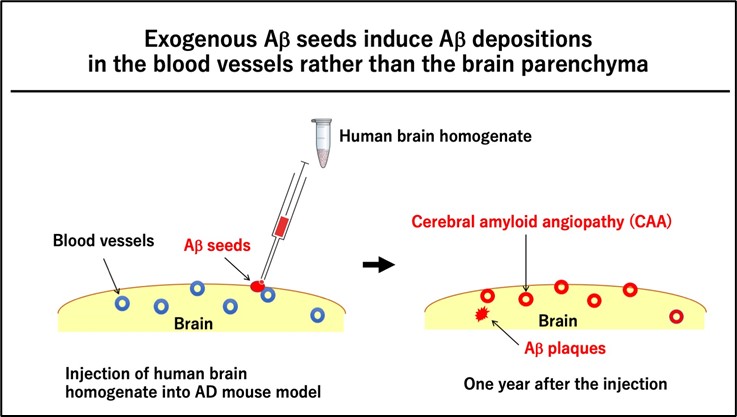Abstract: Researchers from Kanazawa University showed that exogenous amyloid β protein (Aβ) seeds from different Aβ pathologies induced Aβ deposition in the blood vessels (cerebral amyloid angiopathy: CAA) rather than the brain parenchyma without being influenced by Aβ strain-specific information, which might be why CAA is a predominant feature of Aβ pathology in iatrogenic transmission cases. Furthermore, transmission of Aβ pathology might occur due to contamination of brain tissues from patients with little Aβ pathology.
Kanazawa, Japan – Alzheimer’s disease (AD) involves the deposition of a protein called amyloid β protein (Aβ) in the brain. This protein can build up in both the functional tissues, or “parenchyma”, of the brain, and in the blood vessels. This can lead to AD, causing dementia, or cerebral amyloid angiopathy (CAA), which can lead to cerebral hemorrhage. The reason for Aβ forming deposits in either of these places remains unknown. Now, new research by a team of researchers from Kanazawa University is shedding light on the deposition patterns formed when Aβ is introduced to the brain from external sources.
Aβ exists in different conformations, or strains. The Kanazawa team investigated whether the strain of Aβ affected the deposition pattern. To study this, they used a mouse model of AD. The most effective mouse models are ones where the mouse is injected with brain extracts from Alzheimer’s patients, known as “seeding”.
The team seeded the mice with Aβ from autopsied patients with different deposition patterns of Aβ, including those with AD, those with CAA, those with both, and those with very little Aβ. After one year, the team compared the patterns of deposition between the mice and the patients from whom the Aβ was taken.
Surprisingly, they found no correlation between the strain of Aβ that the mice were seeded with and the deposition pattern. All the mice showed the Aβ deposition in the blood vessels and had a higher incidence of CAA than mice not seeded with Aβ, regardless of the strain of Aβ.
Seeding of Aβ is not exclusive to mice. It is known that neurosurgeries using tools contaminated with Aβ or the administration of compounds that may be contaminated with Aβ might lead to the development of “iatrogenic” Aβ pathologies in contaminated patients.
“When we induced Aβ deposition using extracts from patients with different Aβ pathologies, we observed deposition in the blood vessels rather than the brain parenchyma, regardless of the strain of Aβ,” explains study lead author Tsuyoshi Hamaguchi. “This may explain why CAA is a predominant feature of the Aβ pathology that we see in iatrogenic transmission cases.”
The researchers also observed that the amount of Aβ deposition induced by brain extracts from the group with less Aβ was higher than that induced by extracts from the other three groups of patients. “This is significant because patients with little Aβ pathology could still cause contamination leading to iatrogenic transmission—indeed, the early phase of Aβ deposition, when little pathology is evident, may in fact be when the transmission risk is highest,” says senior author Masahito Yamada. “Methods to inactivate amyloid β seeding activity are therefore urgently needed.”

Figure
[Funder]
This study was supported by JSPS KAKENHI Grant (JP17H04194) and by a grant-in-aid from the Takeda Science Foundation.
[Article]
Title: Exogenous Aβ seeds induce Aβ depositions in the blood vessels rather than the brain parenchyma, independently of Aβ strain-specific information
Journal: Acta Neuropathologica Communications
Authors: Tsuyoshi Hamaguchi, Jee Hee Kim, Akane Hasegawa, Ritsuko Goto, Kenji Sakai, Kenjiro Ono, Yoshinori Itoh and Masahito Yamada



 PAGE TOP
PAGE TOP